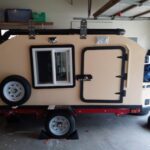Micro Camper Build Phase 1

Initial Planning (or lack of) and Framing
After selling my last RV, I decided to attempt a DIY build for a micro camper. I wanted this for a couple of reasons:
- Travelling between snowbird homes in WA and AZ. I used to use the RV for the primary trip back and forth, could take my time and have a place to stay along the way. Then fly back and forth for holidays, etc. But I do not like flying, unless I am at controls or can easily can get to controls, and airline travel has really started to suck besides.
- To use as a get away to the woods vehicle either in WA or AZ. I love the outdoors and especially fishing, so this becomes my mobile fishing cabin.
- Easy to setup, take down, and get moving. Decided against tent because for one thing I am getting too old, for another I have always been kinda lazy. So with this all I need to do is stop, crawl in and go to sleep.
Besides the reasons I use to justify it above, I also had some primary goals:
- Inexpensive
- Easy to build with limited wood working skills. I am not a carpenter and do not possess those skills. Most of the experience I have is building my living quarters in Vietnam and doing handyman work around the house.
- Not require a lot of fancy woodworking tools. I had a drill, jigsaw, circular saw, chop saw, and a few handtools. Wanted to be able to build this with just what I had.
- Fit into the garage. In the past I had to rent a storage slot for the bigger RV in AZ, didn’t want that hassle.
- Curious to see if I could build one that would work for me and meet my basic needs.
Mistakes along the way:
- My original idea was to keep it very basic, just a place to sleep and store camping items, thus inexpensive. I had watched numerous YouTube videos on DIY campers and thought I could get by with just the basics. But as you will see as we move along, watching the YouTube videos was a mistake, my wish list starting growing and getting bigger and thus my cost went up.
- Shape. I curved the front and back, because I thought it would look good. Wish I had left the back square. The curve interferes with the top shelve and takes away some storage space. It adds nothing, therefore a waste.
- When building the roof, I went from outside in, should have been the reverse and things would have flowed better.
- No overall design. I am a invent it as I go guy, so while I had a basic idea, not plan. So things just kinda of happened as I thought of them. All in all it turned out OK, but could have been so much easier with a plan and an idea of what to do when.
Design concept:
- Sleeping accommodations for 1. Very doubtful my wife wants to go out boondocking without the basics of bath and kitchen. Also doubtful she wants go while I go fishing somewhere. So its just me.
- Small basic rear galley. Just me and my cooking needs are small, so mainly an area to store food and cooking tools.
- Lightweight, going to put it with existing autos, so less than 1500 lbs GVW.
Getting Started:
Trailer: I looked for used trailers on line, but this is a service area, especially yard services, and used trailers were as much as a new trailer. So I decided on a Harbor Freight trailer and got the 1400 lb model. Got 25% off so think it was around $250. Assembled it in my garage in about 2 hours and the game was on.
I then tried to figure out how much and what wood I needed. I had to order it delivered due to no more pickup and wanted to get as much as appropriate on one load. I decided on 3/4 inch plywood side walls and floor of trailer, 2×3 front wall and roof studs, 1/4 inch luau wood for roof, 1/2 plywood for front and floor, plenty of 2×2 for supports, and 1×2 furring for trim. Placed the order and got it delivered. Remarkedly I did a pretty good job of estimating here. I have had to return to get some basic items, mostly hardware and some more 1×3, but these all fit into car so no more deliveries.
The build:
So now it was go time.
- I had a bunch of paint and roof sealer on hand already. So I coated a 3/4 plywood in Flex Seal for water protection, flipped it over and used it as the foundation flooring.
- Put down 2×3 studs along edge of floor, recess 3/4 inch to along for side walls.
- Cut the side walls with curves in front and rear.
- Cut the door. Careful here. I had decided to build my own door as “inexpensive” was still a primary goal. I wanted the cut out section to fit right back in as the door. Then all I would need to do is trim it to be a good seal and would have a door. Since I had not decided while windows to use, I did nt cut them out at this tiime.
- Glued and screwed the side walls to the floor studs. Used scraps to keep alignment while drying.
- Decided to make an under bed storage area and marked out the place for the galley.
- Finished roof front wall studs and applied roof and front wall covering.
This will end Phase 1. The album below contains photographs of the framing phase. I went pretty well and I was able to complete it in 2-3 days.
The second set of photographs shows the build up until its maiden voyage and some of the revisions I started after that.
Micro Camper Build
Mico Camper Build Galleries
- Micro Camper Build
- Micro Camper Phase 1 – Framing
- Micro Camper Phase 2 – PMF and Paint
- Micro Camper Phase 3 – Finish Galley and Interior
- Micro Camper – Maiden Voyage
- Micro Camper – Revisions
- Micro Camper 2.0


